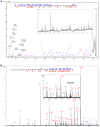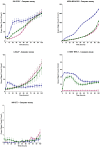APETx4, a Novel Sea Anemone Toxin and a Modulator of the Cancer-Relevant Potassium Channel KV10.1
- PMID: 28902151
- PMCID: PMC5618426
- DOI: 10.3390/md15090287
APETx4, a Novel Sea Anemone Toxin and a Modulator of the Cancer-Relevant Potassium Channel KV10.1
Abstract
The human ether-à-go-go channel (hEag1 or KV10.1) is a cancer-relevant voltage-gated potassium channel that is overexpressed in a majority of human tumors. Peptides that are able to selectively inhibit this channel can be lead compounds in the search for new anticancer drugs. Here, we report the activity-guided purification and electrophysiological characterization of a novel KV10.1 inhibitor from the sea anemone Anthopleura elegantissima. Purified sea anemone fractions were screened for inhibitory activity on KV10.1 by measuring whole-cell currents as expressed in Xenopus laevis oocytes using the two-microelectrode voltage clamp technique. Fractions that showed activity on Kv10.1 were further purified by RP-HPLC. The amino acid sequence of the peptide was determined by a combination of MALDI- LIFT-TOF/TOF MS/MS and CID-ESI-FT-ICR MS/MS and showed a high similarity with APETx1 and APETx3 and was therefore named APETx4. Subsequently, the peptide was electrophysiologically characterized on KV10.1. The selectivity of the toxin was investigated on an array of voltage-gated ion channels, including the cardiac human ether-à-go-go-related gene potassium channel (hERG or Kv11.1). The toxin inhibits KV10.1 with an IC50 value of 1.1 μM. In the presence of a similar toxin concentration, a shift of the activation curve towards more positive potentials was observed. Similar to the effect of the gating modifier toxin APETx1 on hERG, the inhibition of Kv10.1 by the isolated toxin is reduced at more positive voltages and the peptide seems to keep the channel in a closed state. Although the peptide also induces inhibitory effects on other KV and NaV channels, it exhibits no significant effect on hERG. Moreover, APETx4 induces a concentration-dependent cytotoxic and proapoptotic effect in various cancerous and noncancerous cell lines. This newly identified KV10.1 inhibitor can be used as a tool to further characterize the oncogenic channel KV10.1 or as a scaffold for the design and synthesis of more potent and safer anticancer drugs.
Keywords: APETx; KV10.1; cancer; potassium channel; sea anemone peptide.
Conflict of interest statement
The authors declare no conflict of interest.
Figures








Similar articles
-
A natural point mutation changes both target selectivity and mechanism of action of sea anemone toxins.FASEB J. 2012 Dec;26(12):5141-51. doi: 10.1096/fj.12-218479. Epub 2012 Sep 12. FASEB J. 2012. PMID: 22972919
-
APETx1, a new toxin from the sea anemone Anthopleura elegantissima, blocks voltage-gated human ether-a-go-go-related gene potassium channels.Mol Pharmacol. 2003 Jul;64(1):59-69. doi: 10.1124/mol.64.1.59. Mol Pharmacol. 2003. PMID: 12815161
-
A bifunctional sea anemone peptide with Kunitz type protease and potassium channel inhibiting properties.Biochem Pharmacol. 2011 Jul 1;82(1):81-90. doi: 10.1016/j.bcp.2011.03.023. Epub 2011 Apr 6. Biochem Pharmacol. 2011. PMID: 21477583
-
Novel peptide toxins recently isolated from sea anemones.Toxicon. 2009 Dec 15;54(8):1112-8. doi: 10.1016/j.toxicon.2009.02.031. Epub 2009 Mar 6. Toxicon. 2009. PMID: 19269303 Review.
-
Toxins interacting with ether-à-go-go-related gene voltage-dependent potassium channels.Toxicon. 2007 Feb;49(2):239-48. doi: 10.1016/j.toxicon.2006.09.025. Epub 2006 Oct 10. Toxicon. 2007. PMID: 17097705 Review.
Cited by
-
Sea Anemones: Quiet Achievers in the Field of Peptide Toxins.Toxins (Basel). 2018 Jan 8;10(1):36. doi: 10.3390/toxins10010036. Toxins (Basel). 2018. PMID: 29316700 Free PMC article. Review.
-
A Tale of Toxin Promiscuity: The Versatile Pharmacological Effects of Hcr 1b-2 Sea Anemone Peptide on Voltage-Gated Ion Channels.Mar Drugs. 2022 Feb 17;20(2):147. doi: 10.3390/md20020147. Mar Drugs. 2022. PMID: 35200676 Free PMC article.
-
Combined transcriptomic and proteomic analysis reveals a diversity of venom-related and toxin-like peptides expressed in the mat anemone Zoanthus natalensis (Cnidaria, Hexacorallia).Arch Toxicol. 2019 Jun;93(6):1745-1767. doi: 10.1007/s00204-019-02456-z. Epub 2019 Jun 15. Arch Toxicol. 2019. PMID: 31203412
-
A comparative analysis of toxin gene families across diverse sea anemone species.Toxicon X. 2025 Mar 7;26:100217. doi: 10.1016/j.toxcx.2025.100217. eCollection 2025 Jun. Toxicon X. 2025. PMID: 40162058 Free PMC article.
-
Design of ion channel blocking, toxin-like Kunitz inhibitor peptides from the tapeworm, Echinococcus granulosus, with potential anti-cancer activity.Sci Rep. 2023 Jul 15;13(1):11465. doi: 10.1038/s41598-023-38159-w. Sci Rep. 2023. PMID: 37454225 Free PMC article.
References
-
- World Health Organization (WHO) Cancer: Fact Sheet. February 2017. [(accessed on 14 June 2017)]; Available online: http://www.who.int/mediacentre/factsheets/fs297/en/
-
- American Cancer Society Global Cancer Facts & Figures 3rd Edition. Am. Cancer Soc. 2015 doi: 10.1002/ijc.27711. - DOI
MeSH terms
Substances
LinkOut - more resources
Full Text Sources
Other Literature Sources

